


Beethoven Symphonies 1-9. This is a box set of all 9 Beethoven symphonies with Iván Fischer conducting the Royal Concertgebouw Orchestra and the Netherlands Radio Choir. Recorded live at the Concertgebouw in Amsterdam on 11 May 2013 (1, 2, & 5), 31 May 2013 (3 & 4), 9-10 January 2014 (6 & 7), and 20-21 February 2014 (8 & 9). Symphony No. 9 features Myrto Papatanasiu (soprano), Bernarda Fink (mezzo-soprano), Burkhard Fritz (tenor), and Gerald Finley (bass). Title is available also in DVD, but recordings of single symphonies are not offered. Sound is 96 kHz, 24 bit in LPCM 2.0, and DTS-HD MA 5.0. (It is clearly noted in the booklet and on the cases that both sound formats are 96/24.) All symphonies directed for TV by Dick Kuijs. Released 2015. Grade: B- as an average for the whole box.
The beautiful Concertgebouw (Concert Hall)
Iván Fischer
High-definition video consumers may have avoided this issue because of the flawed RCO Mahler box set issue which received an overall grade of D on HDVDarts.com. I am happy to report that the RCO label has made some amends; however, this brief review will demonstrate that this set does not deserve a top grade.
We'll start with some general comments on performance. I believe this to be a fine version of these Beethoven masterworks. Similar to other Fischer recordings (e.g. Mahler 4), he brings a lightness and transparency to the music. The tempi always feel well-considered --- never impeding forward momentum, while allowing space for the RCO musicians to create beautiful sounds and phrases. Rhythmic drive and a keen observation of accents (not sure if they are all Beethoven's) highlight folk elements in the music. Conversations and passing lines between groups of musicians are emphasized notably by Fischer, which adds good interest both aurally and visually. While the performances do not have the same raw energy or ferocity as some interpreters, I believe Fischer’s style to be both valid and interesting. This is a set very worthy of repeated listening.
There are no subtitles on any of the discs in this set. So there are no lyrics provided for the choral finale of the Symphony No. 9, although I did not consider this significant enough to deduct for (others may disagree!). For me, the nuances of the text are not imperative to understanding the music. The word “Freude” (Joy) is the most relevant, especially in terms of the feeling behind the music.
Picture quality is not quite up to par with the best Blu-ray concert releases; however, I did not find this distracting. I would suggest that it is similar to the best of the RCO Mahler box set. However unlike that set, where the PQ varied between symphonies, I can gladly report that all of the Beethoven entries are very consistent in their production (including PQ lighting and color). To get things started on an overall grade for the box set, I’ll propose a deduction from A+ to A- (consistent with the Mahler set) for the soft PQ. As the SQ is 96/24, no further reduction is necessary and we are left with an A- as our starting point in the individual symphonies from which to assess against other HDVDarts.com criteria.
I have recorded statistics for 4 symphonies, which represent a range of recording dates. These also represent 4 of the more popular symphonies, so may be of increased interest to readers.
This limitation does make the assignment of a letter grade for the entire box slightly more problematic. HDVDarts.com has established the following rules-of-thumb to identify a Blu-ray with DVDitis:
A good symphony HDVD should have a slow pace with more than 10 seconds per video clip on average. 20 to 40% of the clips should be large-scale "supershots." Conductor shots should be less than 20% of the clips in the video.
Now let's look at the numbers for the 4 symphonies:
Symphony No. 3 video clip statistics:
Conductor clips = 30
C/B clips = 33
Solos, small section, small group clips = 231
*Large section, large group clips = 45
*Part orchestra clips = 38
*Whole orchestra clips = 11
Instrument only clips = 12
There's a total of 400 clips over 52.5 minutes of music, which yields a pace of 7.9 seconds per clip. There are 94 supershots (marked with "*") above, so 24% (23.5% rounded up) of the total clips in the video are large-scale shots. There are 63 total conductor shots, which is 16% of total clips.
Subject title meets the criteria for supershots and conductor shots, but fails the pace criterion. Deducting a full letter grade for too-fast pace from our base of A-, we get a grade of B- for Symphony No. 3.
Symphony No. 5 video clip statistics:
Conductor clips = 45
C/B clips = 15
Solos, small section, small group clips = 154
*Large section, large group clips = 47
*Part orchestra clips = 25
*Whole orchestra clips = 3
Instrument only clips = 11
There's a total of 300 clips over 33 minutes of music, which yields a blistering pace of 6.6 seconds per clip . . . although I have to say I double-checked my math, since it didn't feel that fast to me. There are 75 supershots (marked with "*") above, so 25% of the total clips in the video are large-scale shots. There are 60 total conductor shots, which is 20% of total clips.
Subject title is marginal on supershots and conductor shots, and fails the pace criterion. Starting with our grade of A-, we knock a full letter grade for failing the pace criterion. This brings us from an A- to a B-. I believe the marginal nature of the other two criteria should bring the grade for this symphony to a C+.
Symphony No. 6 video clip statistics:
Conductor clips = 45
C/B clips = 27
Solos, small section, small group clips = 202
*Large section, large group clips = 46
*Part orchestra clips = 30
*Whole orchestra clips = 4
Instrument only clips = 4
There's a total of 358 clips over 47 minutes of music, which yields a pace of 7.9 seconds per clip. There are 80 supershots (marked with "*") above, so 22% of the total clips in the video are large-scale shots. There are 72 total conductor shots, which is 20% of total clips.
Subject title is marginal on supershots and conductor shots, and fails the pace criterion. As with the Symphony No. 5, this results in a grade for this symphony of a C+.
Symphony No. 9 video clip statistics:
It has been recognized elsewhere on HDVDarts that soloist shots tend to improve the statistics for a given title. The soloist shots would be the same for a DVD or HDVD. So they can therefore can be counted along with other “supershots”. Such is the case here.
Conductor clips = 70
C/B clips = 15
Solos, small section, small group clips = 247
*Soloists = 25
*Large section, large group clips = 91
*Part orchestra clips = 42
*Whole orchestra clips = 16
Instrument only clips = 6
"Anthill" shot with the orchestra so tiny you can't see anything = 1
There's a total of 513 clips over nearly 69 minutes of music, which yields a pace of just over 8 seconds per clip. There are 175 supershots (marked with "*") above, so 34% of the total clips in the video are large-scale shots. If the Soloist shots are removed, this still leaves 29% - considered a good sign! There are 85 total conductor shots, which is 17% of total clips.
Subject title meets 2 out 3 criteria, unfortunately failing on pace. Deducting a full letter grade for the pace criterion from our base of A- results in a grade of B- for Symphony No. 9.
Thank you for enduring so many numbers. Your reward will be screenshots from 3 of the symphonies.
Screen shots of Symphony No. 5:
The next 4 shots (from S5) can be considered typical views, as they are used frequently throughout the entire box set:
Large-section shots are sometimes not of the highest quality, with camera angles making it seem like the musicians are seated in very close proximity. Here’s a view of the violas, albeit poor, with their graceful tune that opens the 2nd Movement. I don’t recall too many attempts in Blu-ray concerts to film the violas as a section!
To my recollection, this box set only contains very rare instances of weird shots. I thought it was worth sharing these 2 images from Symphony No. 5 as an example of ones that were surprising to me:
Screen shots of Symphony No. 6:
The part-orchestra shot below is perhaps a little better lit and clearer than the same shot in Symphony No. 5:
I thought the next two shots below were good large-section shots. First we see the 2nd violins (situated to Fischer’s right), and next the double basses:
Screen shots of Symphony No. 9:
This shot provides a good view of how the soloists were situated for this performance — very widely spaced! However, they perform very well as a group:
Next below is a whole-orchestra shot as the double basses introduce the famous Ode to Joy melody. I found the large-scale image highlighted and contrasted well with the intimate scoring in this section:
I’ll close with 3 good chorus images. All-in-all, this was a satisfying performance (both visually and aurally) of this great work:
Now for a grade for the box. As I have shown, all 4 symphonies failed the pace criterion. I am sure this is true throughout the set.
The 4 symphonies all passed the “supershot” criterion, but 2 of the 4 only barely achieve this. Given the results on the 4 symphonies and the feeling of consistency between concerts, I believe it is reasonable to assume that all symphonies only marginally have enough supershots.
As for conductor shots, 2 of the 4 symphonies passed. 2 others were exactly at 20%. Personally, I very much enjoy watching Iván Fischer’s conducting style. I believe I can hear the musicians responding to his movements and gestures, which adds to the excitement and feeling of spontaneity in the performances. Given the feeling of consistency between concerts, I believe it is reasonable to assume that all symphonies pass the conductor shots test, but several just barely.
Using A- as the starting point (adjusted for PQ and SQ), we deduct a full grade for the fast pace to B-. I believe it is necessary and appropriate to deduct slightly for the marginal performance against the other 2 criteria, bringing the overall grade of this box set to a C+. But I also note that there are relative few instrument-only shots shown in the statistics. Although TV Director Dick Kuijs isn't perfect, I don't see a large number of pointless views or bad shots with framing issues, focus problems, and the like. So I gently move the grade by up a notch to "B-." RCO is making progress, but this Blu-ray box still has too many DVD-like characteristics to get a top grade on this website.
















